How to position SYNCHRON-ized instruments?
- E)
- D)
Positioning "SYNCHRON" Instruments
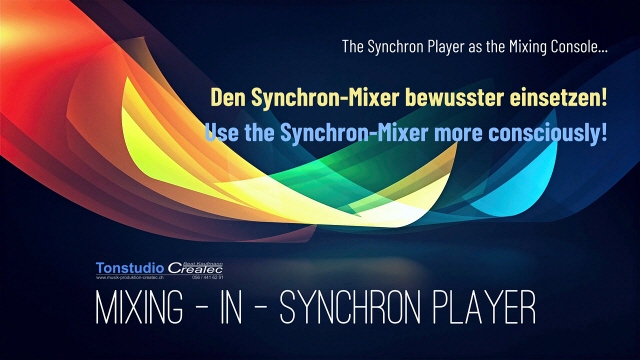
With the SYNCHRON libraries you have different microphone signals with which you can achieve a certain spatial depth by adjusting different volume ratios.
With the balance pot you can still shift the instruments from right to left. I have made a video about this. Click on the picture to see the video.
Even more info you will find here...
Positioning "SYNCHRON-ized" Instruments
With the SYNCHRON-ized libraries, you don't have the different microphone signals. On the contrary, the samples were recorded in the Silent Stage - as dry as possible and without room content.
But the SYNCHRON-ized VI samples wouldn't be called that if they hadn't been adapted to the Synchron Stage. Consider the picture below...
- 1. Here you get presets for each instrument which position it at different places on the virtual stage. If you want to choose a position yourself, I recommend choosing the "Default" preset.
- 2. Click on the small wave icon. A window with different impulse responses will open. Depending on how many libraries you have, there can be more or less. Below you will work out 4 examples with it.
- 3. Depending on the choice of impulse response and the value at DRY/WET (3b), the respective instrument sounds further away or closer. With high values for DRY/WET the instrument sounds further away and vice versa.
- 4. With the panning knob you can set whether an instrument should sound more to the right, to the left or in the middle.
So, roughly speaking, this is how the individual, own positioning of SYNCHRON-ized instruments happens.
Here I show in detail how to set the 4 positions of the solo violin yourself (without preset) so that they match the instruments of the Synchron-Libraries.
After that you should be able to set positions you have chosen yourself.
Position 1
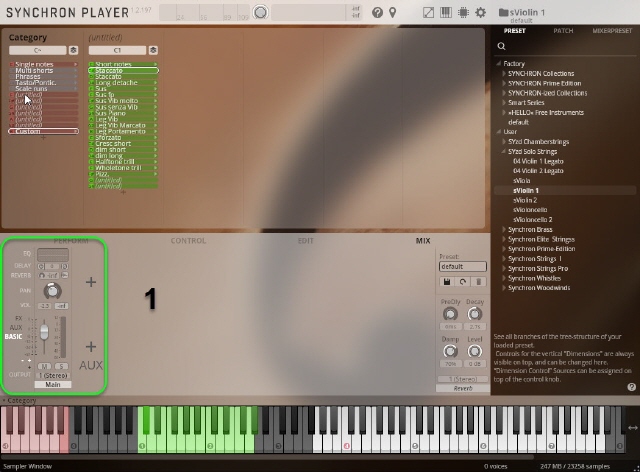
The violin is slightly to the left at the edge of the stage. It is certainly the solo violin that is supposed to play in front of an orchestra. It does not need any depth at all. On the contrary, it is good that it sounds so close and so dry. We bring it slightly to the left as on the stage picture and do this with the panning knob. There is nothing more to do.
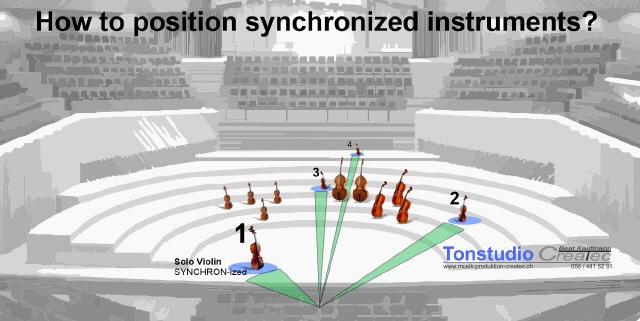
Together with a few "pizzicato string instruments" from the SYNCHRON library "Elite Strings" our solo violin sounds like this:
You may have noticed that there is no reverb effect yet, which would make the whole thing sound a bit more natural. Unlike the VSL presets, which give each instrument a reverb, we only integrate one reverb effect, but in the output channel of the DAW. This "reverb tail over everything" then makes all instruments sound like they are in the same room. And it sounds like this...
Position 2
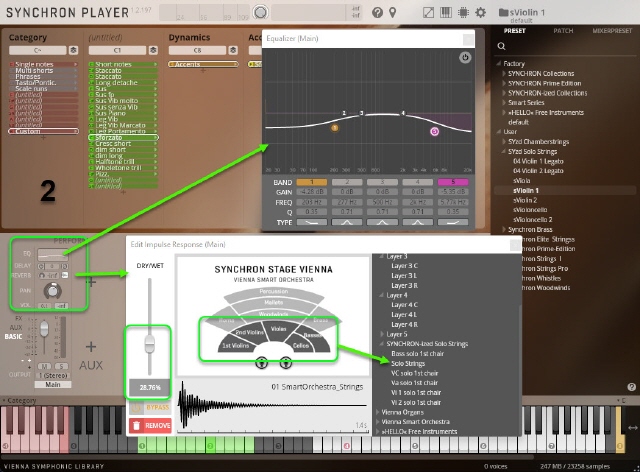
This violin is a bit further away and quite right. So now we need an impulse (IR = Impulse Response) of the SYCHRON stage to push the instrument a bit deeper in the room. It's best to use a stereo impulse, because the violin is still so close that we don't want to lose its stereo sound. I chose the "Solo Strings" IR in the Impulse Library of the same name. This IR is in stereo and therefore makes the violin sound quite spatial, pretty and natural. In any case, the sound fits well with the rest of the SYNCHRON strings.

With DRY/WET I set a value of about 30% so that the distance of the violin sounds like in the plan. With the EQ I attenuated a bit the high and low frequencies to simulate the distant sound.
And this is how it sounds for "Position 2" - first dry and then again with some reverb tail in the output channel...
Position 3

The violin is even further away and quite in the middle. I used the IR "Solo Strings" again. DRY/WET now gave a value of about 39%-40% to get the necessary distance of the violin. To make the violin sound more mono (because it is further away), I chose the Powerpanner instead of the Panning knob to narrow the violin stereo sound a bit (more mono).
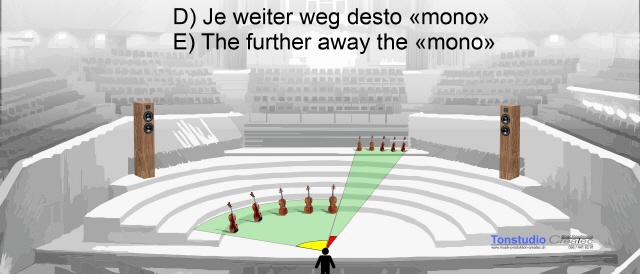
On the stage picture I tried to draw in why distant instruments always sound more mono (more out of a point) - shown with the green angles. This is more noticeable with ensembles. Also, the EQ comes into play here again.

It attenuates the high frequencies, as is also the case in nature with more distant sounding instruments. Now even more than in point 2. Also, the violin no longer sounds as full, which is why the low-shelf filter.
Position 4 (a)
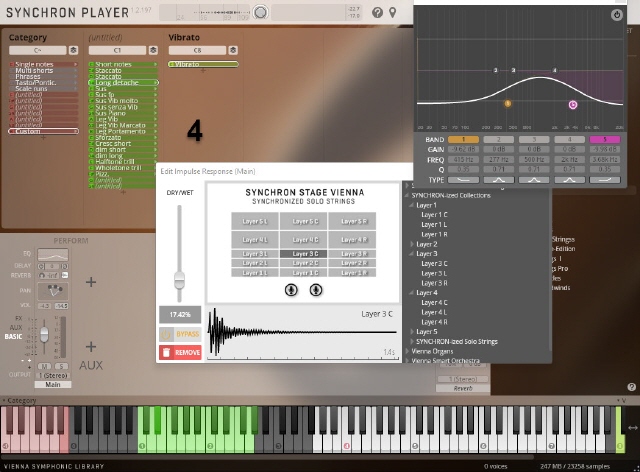
The violin is further away again and slightly to the right. Because the violin only sounds from one point at this distance, we can now try to use a mono impulse to adjust the distance. I used IR "Layer 3C" which contains distance and position. With the PowerPan I moved the violin a bit more to the right. With DRY/WET a who of 17-18% gave the distance as drawn on the plan.

Somehow the sound doesn't really fit the SYNCHRON pizzicatos like in example 2 and 3 anymore. The IR impulses "SYNCHRON-ized Collections" do something with the Synchronized Violin sound that doesn't like. I wonder if it's the mono impulse that lacks spatiality. If you have many libraries, the number of different SYNCHRON-impulses also increases, so that you almost always find a good sounding IR-variant. It is therefore worth paying some attention to the IR selection.
Position 4b
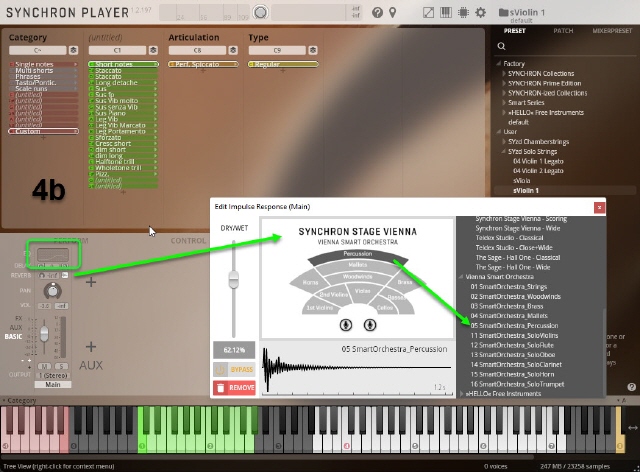
The sound of the "violin position 4" gave me no peace. I searched among my IR impulses for one that allows positions far away, but at the same time is a stereo impulse, so it sounds nice and spatial. I found one at "SMART-ORCHESTRA" and that was the one for the "PERCUSSION". This is meant to let instruments play nicely in the back of the SYNCHRON stage.
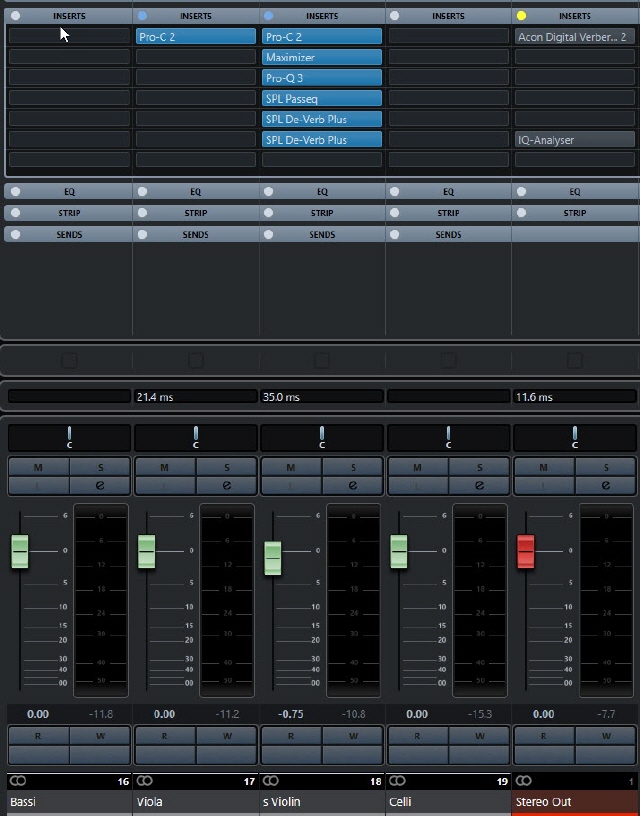
I switched off the EQ in the SYNCHRON player and tried to simulate the distance - just a bit more elaborate - with various effects within the audio channel of the instrument. Anyway, I think the example 4b sounds more real than the violin sounded at 4a.
I hope that with this tutorial I could motivate you to place instruments yourself using the natural sounds of the preset "DEFAULT". The presets of VSL are only offers.
Good luck with the positioning of Synchronized Instruments.
Positionierung der "SYNCHRON"-Instrumente

Bei den SYNCHRON-Libraries hat man verschiedene Mikrofonsignale, mit denen man durch das Einstellen verschiedener Lautstärkeverhältnisse eine bestimmte Raumtiefe erreichen kann.
Mit dem Balance-Poti kann man die Instrumente noch von Rechts bis Links verschieben. Dazu habe ich ein Video gemacht. Klicken Sie aufs Bild, um das Video zu sehen.
Noch mehr Information finden Sie hier...
Positionierung "SYNCHRON-ized" Instrumente
Bei den SYNCHRON-ized-Libraries hat man die verschiedenen Mikrofonsignale nicht. Im Gegenteil, die Samples wurden in der Silent Stage aufgenommen - möglichst trocken und ohne Raumanteil.
Aber die SYNCHRON-ized-VI-Samples würden nicht so heissen, wenn sie nicht an die Synchron-Stage angepasst worden wären. Betrachten Sie das Bild unten...
- 1. Hier erhalten Sie für jedes Instrument Presets, die es an verschiedenen Orten auf der virtuellen Bühne positionieren. Wenn Sie selber eine Position wählen wollen, dann empfehle ich das Preset "Default" zu wählen.
- 2. Klicken Sie auf das kleine Wellen-Symbohl. Es öffnet sich ein Fenster mit verschiedenen Impulsantworten. Je nachdem wie viele Libraries Sie haben, können es mehr oder weniger sein. Weiter unten werden damit 4 Beispiele erarbeitet.
- 3. Je nach Wahl der Impulsantwort und dem Wert bei DRY/WET (3b) erklingt das jeweilige Instrument weiter entfernt oder näher. Bei hohen Werten bei DRY/WET klingt das Instrument weiter entfernt und umgekehrt.
- 4. Mit dem Panning-Knopf kann man einstellen, ob ein Instrument eher rechts, links oder in der Mitte klingen soll.
So geschieht also grob gesagt das individuelle, eigene Positionieren von SYNCHRON-ized Instrumenten.
Ich zeige hier im Detail, wie man selber (ohne Preset) die 4 Positionen der Solovioline einstellt, so dass diese zu den Instrumenten der Synchron-Libraries passen.
Danach sollten Sie in der Lage sein, selber gewählte Positionen einzustellen.
Position 1

Die Violine steht am Bühnenrand leicht links. Sie ist sicher die Solovioline, welche vor einem Orchester spielen soll. Sie benötigt überhaupt keine Raumtiefe. Im Gegenteil, es ist gut dass Sie so nahe und so trocken klingt. Wir bringen sie leicht nach links wie auf dem Bühnen-Bild und tun dies mit dem Panning-Knopf. Mehr gibt es nicht zu tun.

Zusammen mit ein paar zupfenden Streichinstrumenten aus der SYNCHRON Library "Elite-Strings" klingt unsere Solo-Violine so:
Sicher ist Ihnen aufgefallen, dass bisher noch kein Hall-Effekt dabei ist, der das ganze noch etwas natürlicher klingen lässt. Anders als bei den VSL-Presets, welche jedem Instrument einen Reverb verpassen, integrieren wir nur einen Reverb-Effekt, das aber im Ausgangkanal der DAW. Diese "Hallfahne über allem" lässt dann alle Instrumente wie in einem gemeinsamen Raum erklingen. Und das tönt so...
Position 2

Diese Violine ist etwas weiter entfernt und ziemlich rechts. Wir benötigen nun also einen Impulse (IR = Impulse Response) der SYCHRON-Stage, um das Instrument etwas in die Tiefe zu schieben. Am besten verwenden wir einen Stereo Impuls, denn die Violine ist immer noch so nahe, dass wir ihren Stereo-Sound nicht verlieren wollen. Ich wählte den IR "Solo Strings" in der gleichnamigen Impulse Library. Dieser IR ist in Stereo und lässt deshalb die Violine recht räumlich erklingen. Der Klang passt jedenfalls gut zu den restlichen SYNCHRON-Streichern.

Bei DRY/WET ergibt sich ein Wert von etwa 30% damit die Distanz der Violine etwa so wie im Plan klingt. Mit dem EQ dämpfte ich etwas die hohen und tiefen Frequenzen, um den entfernten Klang zu simulieren.
Und so klingt das Ganze für "Position 2" - zuerst dry und dann wieder mit etwas Hallfahne im Ausgangskanal...
Position 3

Die Violine ist noch weiter entfernt und ziemlich in der Mitte. Ich verwendete nochmals den IR "Solo Strings". DRY/WET ergab nun einen Wert von etwa 39%-40%, um die nötige Distanz der Violine zu erhalten. Damit die Violine mehr mono klingt (weil sie ja weiter entfernt ist), wählte ich statt dem Panning-Knopf den Powerpanner, um den Violinen-Stereoklang etwas einzuengen (mehr mono).

Auf dem Bühnenbild versuchte ich einzuzeichnen, warum entfernte Instrumente immer mehr mono klingen (aus einem Punkt heraus) - dargestellt mit den grünen Winkeln. Bei Ensembles fällt das deutlicher auf.

Auch kommt hier wieder der EQ zum Einsatz. Er dämpft die hohen Frequenzen, wie dies in Natura auch der Fall ist bei weiter entfernt klingenden Instrumenten. Nun noch mehr als bei Punkt 2. Auch klingt die Violine nicht mehr so voll deshalb der Low-Shelf Filter.
Position 4 (a)

Die Violine ist nochmals weiter entfernt und leicht rechts. Weil die Violine aus dieser Distanz nur noch aus einem Punkt tönt, können wir nun einen Mono-Impuls verwenden, um die Distanz einzustellen. Ich verwendete IR "Layer 3C" der Distanz und Position beinhaltet.Mit dem PowerPan schob ich die Violine noch nach etwas rechts. Bei DRY/WET ergab ein Wer um 17-18% die Distanz, wie sie auf dem Plan eingezeichnet ist.

Irgendwie passt der Klang nicht mehr so richtig zu den SYNCHRON-Pizzicatos wie bei Beispiel 2 und 3. Die IR-Impulse "SYNCHRON-ized Collections" machen etwas mit dem Synchronized Violinenklang, das nicht gefällt. Ob es der Mono-Impuls ist, dem die Räumlichkeit fehlt? Wenn man viele Libraries hat, dann steigt auch die Anzahl der verschiedenen SYNCHRON-Impulse, so dass man fast immer eine gut klingende IR-Variante findet. Es lohnt sich deshalb der IR-Auswahl etwas Beachtung zu schenken.
Position 4b

Der Klang der Violinen-Position 4 liess mir keine Ruhe. Ich suchte unter meinen IR-Impulsen einen, der Positionen weit weg ermöglicht, der aber gleichzeitig ein Stereo-Impuls ist, also schön räumlich klingt. Ich fand einen bei "SMART-ORCHESTRA" und zwar jener für die "PERCUSSION". Dieser ist gedacht Instrumente schön hinten in der SYNCHRON-Stage spielen zu lassen.

Den EQ im SYNCHRON-Player schaltete ich ab und versuchte im Audiokanal mit verschiedensten Effekten die Distanz - halt etwas aufwändiger - zu simulieren. Jedenfalls glaube ich, das Beispiel 4b klingt echter, als die Violine bei 4a geklungen hat.
Ich hoffe, dass ich mit dieser Anleitung Sie motivieren konnte, Instrumente selber zu platzieren und dabei die natürlichen Klänge des Presetes "DEFAULT" zu verwenden. Die Presets von VSL sind ja nur Angebote.
Viel Erfolg beim Positionieren von Synchronized Instrumenten.

